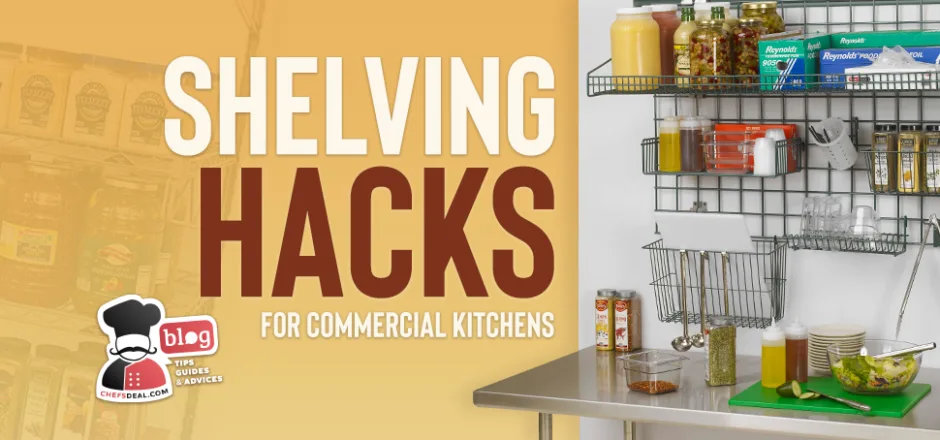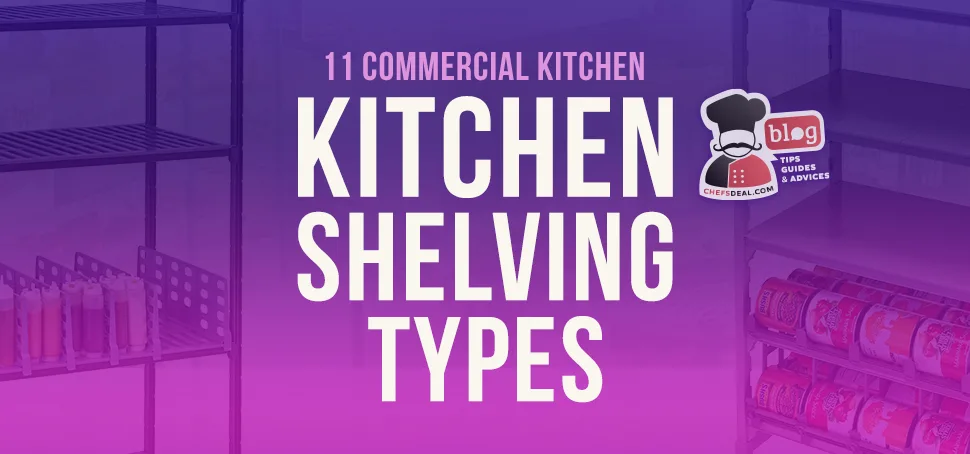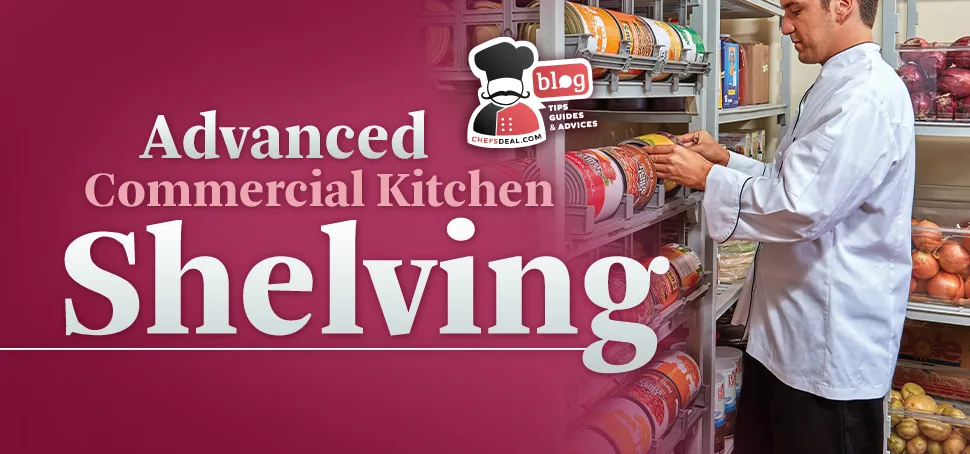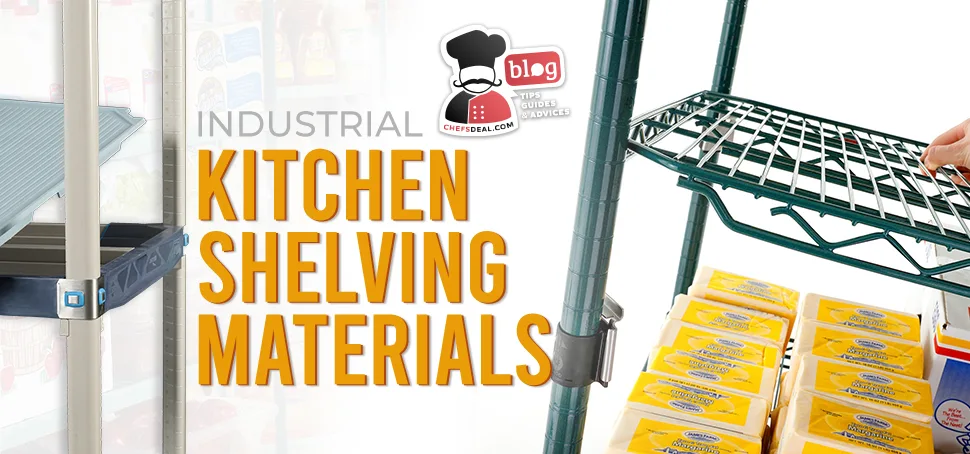Commercial kitchen shelving plays a pivotal role in maximizing storage, organization, efficiency, safety, and sanitation in a commercial kitchen. Proper shelving keeps the kitchen organized, reduces clutter, and enhances productivity and safety by arranging the items, equipment, and products and meeting safety regulations.
Commercial kitchen shelving is used to provide an organized area for storing items such as cookware, utensils, and equipment. They help keep the area organized by arranging items depending on usage areas and provide easy access to the tools and equipment, facilitating all cooking, prep, and serving processes. By using the available space effectively, kitchen shelving maximizes storage and streamlines operations.
Commercial kitchen shelving has several benefits, such as ensuring efficient storage, improved organization, space optimization, and safety and sanitation in kitchens, improving overall operation. 6 shelving hacks listed below enhance these benefits of commercial kitchen shelving:
- Creative Kitchen Design Ideas
- Cost-Effective Solutions
- Maximizing Limited Space with Innovative Solutions
- DIY Methods
- Adaptable Shelving Solutions
- Resourcefulness
Additionally, with insight into different kitchen shelving solutions, every kitchen can optimize the available storage space using various shelving options and practical systems.
1. Creativity in Kitchen Design
Creativity in kitchen design ensures functionality in kitchen shelving and enhances overall decoration. Innovative approaches to commercial kitchen shelving maximize storage and provide practicality in operations. Here are 5 creative shelving and storage hacks and ideas for kitchen designs:
- Using Vertical Space
- Magnetic Storage
- Built-In Power Outlets
- Mobile Shelving
- Using Undercounter Space
Using Vertical Space
Vertical space is one of the most neglected areas of commercial kitchens. Vertical space can provide a functional area for shelving and help maximize storage. Building shelf units up to the ceiling, wall-mounted shelves and racks for storing dry goods, small appliances, and utensils frees up counter space, reduces clutter, and streamlines operation.
Magnetic Storage
Creating magnetic storage areas using magnetic strips or metal pegboards is a creative and efficient way of storing knives and metal utensils. Magnetic strips on walls can hold knives and metal kitchen utensils within easy reach for the staff and save drawer and counter space. Metal pegboards can hold pots, pans, and other tools on walls, adding functionality to kitchen design and maximizing storage space.
Built-In Power Outlets
Using shelving units with built-in power outlets allows equipment, especially huge ones, to be used without requiring a separate power source and without the need to move it. This specialty shelving also removes the cable clutter.
Mobile Shelving
Mobile shelving units are cabinets with wheels. They can transport tools and equipment within the kitchen or create temporary workstations, adding creativity to storage and boosting operational performance. They also provide easy cleaning and free up kitchen space when not in use.
Using Undercounter Space
Undercounter space can be an effective storage area when used. Installing pull-out drawers, shelving, and hooks for storing utensils and tools maximizes kitchen space and keeps the items accessible.
2. Cost-Effective Solutions
Using cost-effective materials and practical storage tools are some of the affordable shelving hacks for optimizing the layout and storage and boosting the performance of all kitchens.
Cost-Effective Materials
Wire, plastic, galvanized steel, particle board, and aluminum are the most cost-effective solutions.
- Wire shelving is inexpensive, durable, and simple to clean, making it one of the most popular kitchen shelving materials. It provides a good display for easily finding items or products. The open wires allow air ventilation throughout the shelves, making them dust-free and ideal for dry food storage. They are also easy to assemble but not suitable for heavy objects. You can use them for storing lightweight or small items.
- Plastic is a cost-effective material that is also lightweight, corrosion-resistant, and cheaper than most materials. Plastic storage bins and shelves can be used for dry food storage and walk-in freezers.
- Galvanized steel shelving provides durability at a moderate cost. It is rust and corrosion-resistant, ideal for humid environments such as walk-in freezers or dishwashing stations.
- Particle board shelving is a cheaper version of wood shelving made of wood chips and resin, ideal for dry storage and lightweight items. It is a cost-effective solution that is lightweight and easy to install. However, it’s not suitable for humid environments with high moisture and is not as durable as wood.
- Aluminum shelving is a cost-effective alternative to stainless steel shelving. It is lightweight, durable, corrosion-resistant, easy to clean, and requires little maintenance.
Practical Tools
Tenison rods, clip hooks, S-hooks, and drawer organizers make the shelving practical and organize the environment for flawless operation and extra storage space.
- Tension rods are an easy and cost-effective way to organize shelves. They can be used as separators between shelves to keep tools neatly sorted, such as baking sheets, trays, or chopping boards. This easy hack maximizes the shelving space and keeps tools organized.
- Clip hooks are great gadgets to attach to wire shelving for extra hanging space for lightweight utensils such as cutlery, aprons, or towels. This cost-effective solution provides easy reach for the items and eliminates the need for drilling holes in the wall for hangers.
- Another tool for hanging utensils is an S-hook. These hooks provide practical storage for pots and pans by hanging from tension rods, pegboards, or wire shelves, freeing up shelf space.
- Drawer organizer inserts keep small things like spices, attachments, and tools organized inside the shelving. This reduces clutter and helps you find what you need easily, improving storage efficiency.
3. Maximizing Limited Space
Optimal space utilization in commercial kitchens is one of the crucial points for a functional design, efficient storage, and maximized performance, especially in kitchens with limited space. The proper shelving design and effective use of space maximize the available storage space and workflow of the kitchen.
Creating Pantry
Creating a pantry in a small kitchen with limited cabinet space is a great way of adding extra storage space. Kitchen pantry shelving can be built into the walls, into existing shelves or cabinets, or as a separate unit. Kitchen pantries mostly consist of shelving, drawers, and racks combined. Bins and baskets add more functionality and storage for different items. A pantry may be used for storing canned items, dry products, and kitchen tools, freeing up counter space.
Utilizing Corner Space
In a small kitchen, every inch of available space, including corners, must be used. Corner shelving increases storage without taking up floor space and functionally repurposes ignored spaces. You can store dishes, spices, or small utensils on corner shelves.
Installing Pegboard
Pegboards are an efficient way to use wall space for extra storage in small kitchens. A pegboard with moveable hooks can hold everything from pans and pots to cutlery and spices. They are easy to install, and the hooks can be rearranged for your changing needs and keep the kitchen decluttered.
Using Inside of Cabinet Doors
Inside the cabinet doors is an effective way of adding extra storage to the kitchen. By installing hooks or shelves, you can use the cabinet doors for storing little utensils such as spoons and measuring cups, freeing up counter space and providing a clean environment.
4. DIY Shelving Hacks
DIY shelving hacks allow you to maximize kitchen storage without breaking the budget and reducing waste. By reusing and repurposing old products and materials, you can save money and tailor storage solutions to your needs while reducing waste and making your operation more environment-friendly. Here are some examples of self-made storage solutions to inspire you:
- T-molding is used for flooring, but you can turn it into a wine glass rack with a little effort. By simply cutting the mold to the depth of your shelving, screwing holes, and securing, you have your self-made wine glass holder. With proper spacing, you can easily put and slide out your glasses.
- PVC pipe works great as a wine rack and only requires something to cut them equally and glue. All you need to do is stack and glue them horizontally as slots to place wine bottles. Now you have a self-made wine bottle holder. Then, you can mount your wine rack on a wall or inside a cabinet to save space.
- You can create a modern-looking and space-saving coffee mug holder by using tension curtain rods and S-hooks. Fixing the rods inside open shelving and hanging cups using S-hooks saves cabinet space and creates an eye-catching design in your kitchen.
- Old pieces of furniture are great for repurposing as a storage unit in a commercial kitchen. Dressers, cabinets, or bookshelves can be turned into shelving units with little changes. You can remove the doors and drawers and use them as a pantry for storing small equipment and goods.
5. Adaptability of Shelving Solutions
Customizable shelving solutions meet the different demands and changing needs of commercial kitchens, making shelving adaptable. Adjustable, modular, and mobile shelvings add flexibility to your storage, meet different needs, and fit different areas. Existing shelves can be customized with little touches and additional tools, such as removing cabinet doors for open shelving, adding separators to the shelves, and hanging utensils using hooks and racks.
Adjustable shelving offers versatility in storing different-sized kitchen equipment and items. Adjusting the height of the shelves for different tools allows for designing storage depending on your needs and provides flexibility for changing kitchens. One of the important factors of industrial kitchen shelving is customizable dimensions, which make it adaptable for any kitchen space and varying demands.
Mobile shelving units come equipped with casters for mobility. They allow for easily changing the layout of the kitchen, creating temporary storage areas, and easy cleaning. Foldable shelves also provide versatility and easy cleaning by folding up when not used, saving space and providing extra storage.
6. Resourcefulness in Shelving
Using repurposed materials for shelving provides sustainability and reduces waste in kitchens. Repurposing materials reduces waste, encourages environmentally responsible activities, and adds unique design touches to the kitchen.
- Reclaimed wood can be obtained from old barn wood or abandoned pallets to create rustic shelving. Wood shelving can suit any design and provide a cozy ambiance to the kitchen.
- Metal shelving or industrial storage racks can be repurposed as kitchen shelving. These durable and corrosion-resistant materials can be used for storing anything and give the area a sleek appearance.
- Wooden crates and boxes can be turned into open shelving units by stacking on top of each other or mounting to walls, creating unique and customizable storage spaces.
- Empty glass or plastic bottles can be repurposed as shelf supports, providing a distinctive touch and an environmentally friendly design in kitchens.
- Bamboo is a renewable and sustainable resource that can also be a great shelving material. It is lightweight, moisture-resistant, and durable, making it ideal for kitchen shelving.
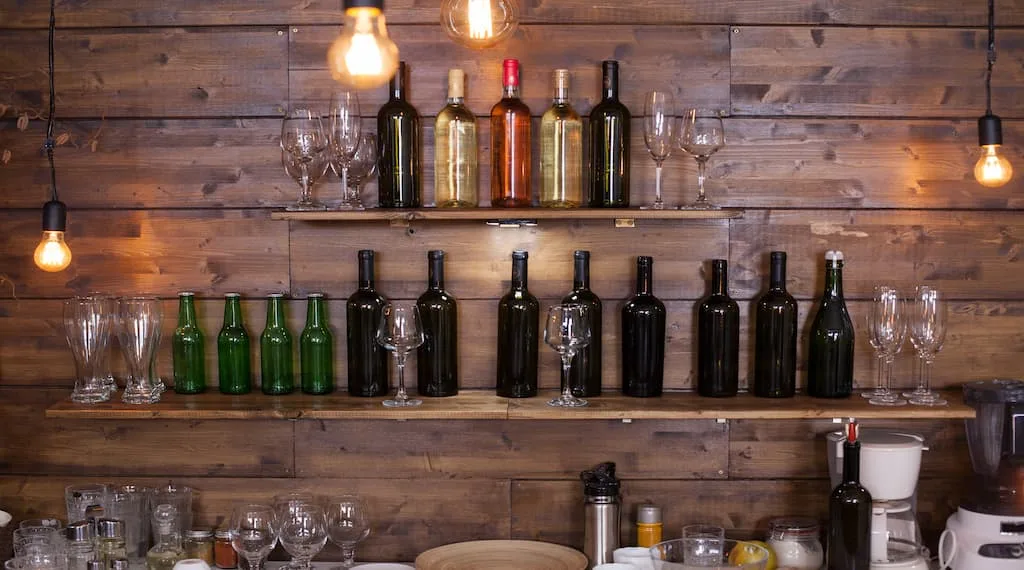
Different Shelving Solutions in Kitchens
Shelving in commercial kitchens is the key element in providing effective storage, leading to efficient and organized working areas. Aside from classical shelving options, innovative and practical shelving solutions maximize storage space and help evaluate every kitchen inch for maximum efficiency.
Wall-Mounted and Pull-Out Shelves
Vertical spaces and hidden, hard-to-reach areas can be ignored in some kitchens, which can be very effective when used properly. Pull-out shelves or drawers maximize storage and facilitate reaching the items at the back of the cabinet, preventing items from getting lost or forgotten. Pull-out pantry increases the storage space by using a little footage and taking advantage of ignored areas. It keeps the items organized and provides easy access and multiple uses.
Using vertical space by mounting wall shelving helps to keep frequently used items at easy reach, maximizes storage, and reduces countertop clutter. You can install wall-mounted shelves above workstations and use them to store items used in each station, providing an organized area and enhancing workflow.
Corner Units and Hanging Systems
Innovative use of corner and overhead areas is a smart option for increasing storage capacity. Using awkward-shaped and ignored areas for storage by installing corner units and hanging shelves repurposes overlooked places without sacrificing square footage and maximizes storage. You can install specifically built open shelves or cabinets in corners and use overhead storage by installing overhead pot racks or ceiling-mounted racks above counters, keeping pots and pans within easy reach and reducing clutter.
Floating shelves above countertops provide additional storage for glasses and dishes while providing a modern look and freeing up cabinet storage. Installing floating shelves near the serving or bar area facilitates serving and keeps the glasses accessible.
Modular and Stackable Options
Modular shelving offers customization and flexibility with interchangeable components and can be expanded by adding modules to tailor to specific layouts of kitchens and different requirements. They can include shelves, dividers, and attachments for adaptability and can be rearranged depending on the changing storage needs. Turning shelves is one of the modular kitchen accessories, consisting of a turning tray inside cabinets, provides easy reach to every item and keeps cabinets organized.
Stackable shelves are mostly made of metal wires and can be turned into vertical shelving units by stacking on top of each other or given different shapes and designs according to the preferences and needs of kitchens. The height of each base can be adjusted for storing different items, making it customizable.
Under-Shelf Baskets and Magnetic Strips
Under-shelf baskets and magnetic strips are additional storage hacks for small items. Under-shelf wire or mesh baskets are designed to hang under counters or shelves with hooks or clips. They come in various sizes for storing small items such as cleaning chemicals and kitchen tools.
Magnetic strips are long strips with magnets made of metal or plastic. They can be mounted on walls, cabinets, or any surface in the kitchen and used to keep knives and metal kitchen tools organized and within easy reach. They free up valuable counter and drawer space and accessibility, especially near prep and cooking areas.
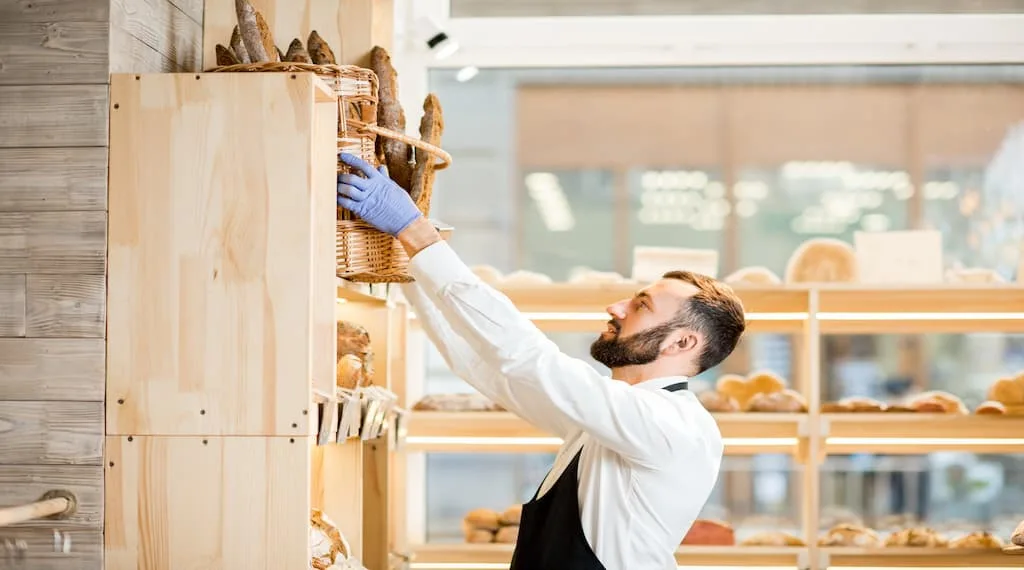
Foldable/Retractable and Pegboard Systems
Foldable and retractable shelving and pegboards are innovative solutions for maximizing kitchen storage. Foldable shelving systems can be folded up when not in use, saving space. They also provide extra or temporary storage space when needed, such as during events or peak restaurant hours. They are flexible and can be adjusted for different needs.
Pegboards are perforated boards with holes into which hooks or pegs are placed for hanging various tools and equipment. These wall-mounted boards store pots, pans, utensils, and tools, providing an organized area, saving cabinet space, and providing accessibility and visibility for staff. They are customizable with additional bins and baskets and can be rearranged depending on storage needs.
Conclusion
Commercial kitchen shelving is a cornerstone for maximizing kitchens’ storage capacity, overall design, performance, and efficiency. Kitchens may benefit from implementing shelving solutions in a variety of ways, including increased storage usage, improved organization, space efficiency, and enhanced safety and cleanliness standards.
By using innovative shelving hacks and creative design ideas, such as maximizing vertical space, implementing cost-effective solutions, incorporating self-made shelving systems, and effectively using limited space, kitchens can elevate their functionality while staying within budget constraints.
Additionally, the adaptability and resourcefulness of shelving solutions allow for customization and flexibility to meet the evolving needs of any kitchen environment. The emphasis on resourcefulness in shelving, including reclaimed materials and DIY solutions, highlights the importance of sustainability and waste reduction in kitchen design.
Exploring different shelving options, such as wall-mounted shelves, pull-out drawers, and modular units, provides insights into optimizing storage and workflow in diverse kitchen environments. By embracing creativity and flexibility in shelving solutions, kitchens can achieve optimal efficiency and productivity while minimizing waste and environmental impact.

